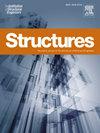Impact of prototype scale effect on the dynamic responses and damage of steel plates under explosions
IF 3.9
2区 工程技术
Q1 ENGINEERING, CIVIL
引用次数: 0
Abstract
Scaling model was widely used in engineering to reveal the responses of full-scale prototype model. This study provided insight into the impact of the scale effect on the dynamic response and damage of stiffened and unstiffened steel plates under explosions. A numerical model consider fluid-structure-interaction (FSI) was established using LS-DYNA platform, and the numerical model was verified by the blast test results. Moreover, the scaling factors () equal to 1 (prototype), 1/2, and 1/4, and 1/8, and 1/12 were considered in the study, the scaling effects on the breach size, plastic area, and the deformation shape were analyzed. The results showed that the breach size and plastic area of the scaled model deviated from the ideal results based on the replica law. However, the deformation shapes of scaled-down plates accurately reflected the deformation characteristics of the full prototype plate. The scaling factor significantly influenced the dynamic responses of stiffened and unstiffened steel plates; as the scaling factor () increased, the dimensionless displacement decreased. The results indicated that a smaller led to a larger deviation in response. The influencing factors of the scaling effect were investigated, and it was found that stiffened steel plates were more sensitive to the scaling factor than unstiffened steel plates. By comparing the detonation of cuboid, cylindrical, and spherical explosives blast-loaded onto stiffened steel plates, it was determined that the detonation of cubic explosives caused the most severe scaling effect on stiffened steel plates under blast loads. The study also found that explosive mass and standoff distance influenced the scaling effect of stiffened steel plates under blast loads. Additionally, steel plates in the plastic stage and the critical state between the elastic and plastic stages were particularly sensitive to the scaling effect. Due to the strain rate effect, which can lead to a deviation from the ideal scale law, different steel materials exhibit varying scale sensitivities. Comparing stiffened plates made from Q235, Q345, DH36, and L907A, the order of sensitivity to the scaling factor was: Q235 > Q345 ≈ DH36 > L907A.原型比例效应对爆炸下钢板动态响应和损坏的影响
工程中广泛使用比例模型来揭示全尺寸原型模型的响应。本研究深入探讨了比例效应对加劲钢板和非加劲钢板在爆炸下的动态响应和破坏的影响。利用 LS-DYNA 平台建立了考虑流固耦合(FSI)的数值模型,并通过爆炸试验结果对数值模型进行了验证。此外,研究还考虑了等于 1(原型)、1/2、1/4、1/8 和 1/12 的缩放因子(),分析了缩放因子对破口尺寸、塑性面积和变形形状的影响。结果表明,缩放模型的破口尺寸和塑性面积偏离了基于复制定律的理想结果。然而,缩小模型的变形形状准确地反映了完整原型板的变形特征。缩放因子对加劲钢板和非加劲钢板的动态响应影响很大;随着缩放因子()的增加,无量纲位移减小。结果表明,缩放因子越小,响应偏差越大。研究了缩放效应的影响因素,发现加劲钢板比非加劲钢板对缩放因子更敏感。通过比较在加硬钢板上爆破装载的立方体、圆柱形和球形炸药的起爆情况,确定在爆破载荷下,立方体炸药的起爆对加硬钢板造成的缩放效应最为严重。研究还发现,在爆炸荷载作用下,炸药质量和间距会影响加劲钢板的缩放效应。此外,处于塑性阶段以及介于弹性和塑性阶段之间临界状态的钢板对缩放效应特别敏感。由于应变率效应会导致理想比例定律出现偏差,不同的钢材料表现出不同的比例敏感性。比较由 Q235、Q345、DH36 和 L907A 制成的加劲板,对缩放因子的敏感性顺序为Q235 > Q345 ≈ DH36 > L907A。
本文章由计算机程序翻译,如有差异,请以英文原文为准。
求助全文
约1分钟内获得全文
求助全文
来源期刊

Structures
Engineering-Architecture
CiteScore
5.70
自引率
17.10%
发文量
1187
期刊介绍:
Structures aims to publish internationally-leading research across the full breadth of structural engineering. Papers for Structures are particularly welcome in which high-quality research will benefit from wide readership of academics and practitioners such that not only high citation rates but also tangible industrial-related pathways to impact are achieved.
 求助内容:
求助内容: 应助结果提醒方式:
应助结果提醒方式:


